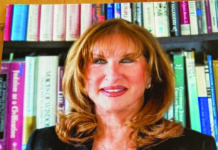
By Rabbi Valerie Joseph
Parshat Terumah
“Speak to the children of Israel and let them take for Me a portion [a donation for the Sanctuary], from every person whose heart motivates him you shall take My portion” Exodus 25:2.
“They shall make a Sanctuary for Me — so that I may dwell among them” Exodus 25:8.
In this week’s Torah reading, G-d speaks to Moses and Israel from Mount Sinai. The Israelites listen and accept the covenant that G-d proposed, saying “We will do and we will listen.”
At this point in the story, the drama of the plagues, the Exodus from Egypt, the parting of the Red Sea, and the wondrous sights and sounds of the Sinai experience are in the past. The Israelites have been made part of history, but have not yet been asked for anything in return. There is an important shift here as G-d introduces the concept of Terumah, or offerings and contributions to the people.
Not only does G-d now ask something of the Israelites, he also gives them gives detailed instructions, which we will hear about in the coming weeks. They are to build a portable sanctuary, which will become the center of community life during the coming years of wandering.
Awed by G-d, the Israelites respond “we will do,” which is an admirable change, after following behind the leadership of Moses and Aaron out of Egypt. It’s an important step toward freedom. But the word used by G-d is not “to give,” but rather “to take for me a donation.” Why use the word take instead of give?
Rabbi David of Kotzk explains with a saying: “A fool gives and a wise man takes.” It means that a fool thinks he is giving when performing a generous act or making a donation, but it is the wise man who realizes he is taking because he benefits psychologically as much as the taker, based on a desire to become part of something larger.
The Israelites are asked “to take,” not as an obligation but as their hearts move them — and as a group, to create through the sharing of textiles and metals, a place for G-d to reside amongst them, where they gather. And give they do, recognizing the value they are receiving in return: community, ownership, active participation and more. Each gives his own portion of contribution with open heartedness and shares in the finished product of a sanctuary.
The Israelites in this week’s reading are in the process of becoming a single people and a nation with shared ideals. The ethereal G-d asks them for a physically distinctive and sacred place to reside. It’s a defining moment in their fluid life of wandering and, as opposed to the destructiveness of the golden calf, they work together to create an inspiring sacred sanctuary.
Bezalel, the architect who transforms G-d’s detailed instructions into reality, is the main player in the narrative, while Moses is still up in the clouds, so to speak. With Bezalel, the Israelites on the ground transform from former slaves into demonstrably free people, and they are transformed internally and psychically.
And as a result of the Terumah, contributions that they took and brought to this moment, the people, rather than Moses, will bring G-d’s presence to earth in a physical sign that joins them as they journey. They’ve created something bigger than themselves.
So why build a sanctuary?
Isn’t this a paradox, since G-d doesn’t need a temple or sanctuary to “be,” as the whole universe is filled with His presence? It is rather our need to gather and give back in gratitude, to build structures, whether they be in someone’s home or a building modest or otherwise, that creates the holy space. Fifteenth-century commentator Abravanel notes that the sanctuary allows the feminine presence of G-d, known as the Shechinah, to dwell within and among them.
This week, we see a tangible representation of G-d’s presence, created by the people. It is a lesson we can learn about recovery from the pandemic, addressing climate change and addressing other natural and man-made events of the recent past.
May we all gather together soon again, not in just the “cloud,” that is, online, but in those structures, such as synagogues, we have contributed to through our volunteering and through material gifts, where we share our life cycle events as a community. l
Rabbi Valerie Joseph is a board-certified chaplain and a retired rabbi who leads morning minyan at Congregation Kesher Israel each week. The Board of Rabbis is proud to provide diverse perspectives on Torah commentary for the Jewish Exponent. The opinions expressed in this column are the author’s own and do not reflect the view of the Board of Rabbis.





